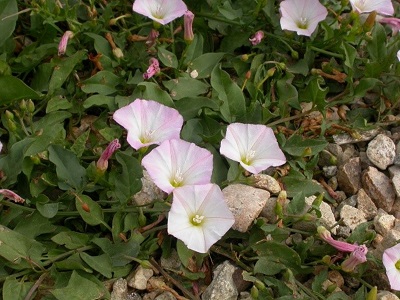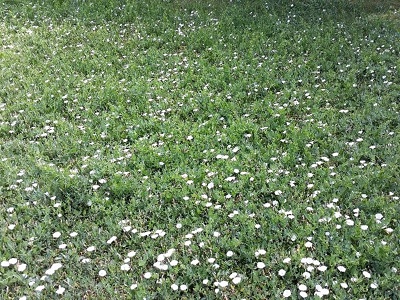Field bindweed-April 2019
Download weed post on field bindweed as a PDF (contains word puzzle)
Introduction

Photo by Mat Lavin.
Field bindweed is native to Eurasia and was first identified in North America as early as 1739. It was likely introduced as a contaminant in crop seed. It has been reported in every state in the United States and is on 22 state noxious weed lists. Field bindweed is a priority 2B noxious weed in Montana, meaning it is an abundant and widespread weed. It has been reported in every county in Montana.
Identification and biology
Field bindweed is a perennial rhizomatous forb and is also known by the common names of creeping jenny, European bindweed, and perennial morning glory. Trumpet- or funnel-shaped flowers are about one inch wide, white, and sometimes tinted pink. Dark green, hairless leaves are up to two inches long and one inch wide, arrowhead-shaped, and have a rounded to pointed tip. Stems are one to four feet long, and they may climb or grow horizontally along the ground in mats. Small round fruits contain four brown seeds.
Habitat and spread

Photo by Stacy Davis.
Field bindweed grows across a wide range of settings but is most common in agricultural fields, pastures, hay fields, gardens, lawns, roadsides, and other disturbed areas. Field bindweed spreads from both seed and creeping roots. Reproductive buds found on the roots and underground stems can produce new plants when they are cut and spread by tillage equipment. Seeds are dispersed locally as well as more distantly with harvesting equipment and as a contaminant in crop seed. Field bindweed seeds are long-lived (e.g., 20 or more years).
Impacts
Field bindweed has a twining growth habit and can form dense, tangled mats which interfere with harvesting. While field bindweed is most problematic in agricultural fields, particularly organic systems, it is a weed in turfgrass and a concern in perennial pastures. Alkaloids found in field bindweed are mildly toxic to certain types of livestock (e.g., pigs and horses) and can cause digestive disturbances.
Management options
Field bindweed is difficult to control due to its long-lived seeds and extensive root system that can re-sprout after most management actions. The key to managing field bindweed is depleting root reserves and reducing its re-sprouting ability, which takes time and persistence. Mechanical control methods need to be repeated every couple of weeks during the growing season for several years to effectively remove field bindweed shoots and roots. Mowing is not considered effective as field bindweed is a low-growing plant. Pulling, burning, and mechanical cultivation may be used but should be repeated often or integrated with another management approach, such as herbicides, in order to reduce field bindweed. Two biological control agents for field bindweed, Aceria malherbae and Tyta luctuosa, were released in the late 1980s in the United States and Canada, but establishment has been poor. Chemical control of field bindweed is most effective using a systemic herbicide that moves into the root system to kill roots and root buds. Herbicides can be applied in spring or summer, and it is usually recommended to spray when field bindweed is in the bud to full bloom stage. Another option is to treat fall regrowth before the plants are harmed by hard frost or any adverse growing conditions. Herbicides labeled for field bindweed control include 2,4-D, aminocyclopyrachlor + chlorsulfuron (Perspective™), dicamba (Banvel®), glyphosate (Roundup®), imazapic (Plateau®), metsulfuron (Escort®), picloram (Tordon®), and quinclorac (Paramount®). Refer to specific herbicide labels for complete information and recommendations.
For more information, including a look-a-like species, see the new "Weed Fact Sheets: Field Bindweed" (MT201903AG)
